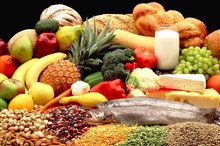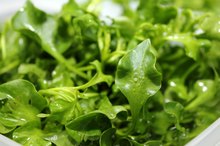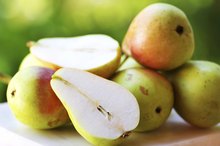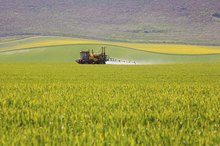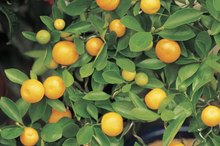What does fact checked mean?
At Healthfully, we strive to deliver objective content that is accurate and up-to-date. Our team periodically reviews articles in order to ensure content quality. The sources cited below consist of evidence from peer-reviewed journals, prominent medical organizations, academic associations, and government data.
The information contained on this site is for informational purposes only, and should not be used as a substitute for the advice of a professional health care provider. Please check with the appropriate physician regarding health questions and concerns. Although we strive to deliver accurate and up-to-date information, no guarantee to that effect is made.
Similarities Between Fruits & Vegetables
Fruits and vegetables are paired together so frequently, it might seem as if they are the same category of food. Webster’s Dictionary defines fruit as “a product of plant growth (as grain, vegetables, or cotton) and the usually edible reproductive body of a seed plant" and vegetables as “a usually herbaceous plant (as the cabbage, bean, or potato) grown for an edible part that is usually eaten as part of a meal.” Fruits are a part of the plant with reproductive responsibilities, while vegetables are the entire plant or edible part of the plant 4. Though the two are different things, they share numerous similarities, especially when it comes to eating.
Characteristics
Both fruits and vegetables are living, whole foods. They grow out of the ground and usually contain seeds, although there are exceptions. In some cases such as tomatoes, cucumbers and squash, the seed is planted to create more of that particular fruit or vegetable. Fruits and vegetables need sun, water and soil to grow 2. Both are also eaten by humans, animals and insects. Fresh fruits and vegetables have a relatively short shelf-life, spoiling if not preserved by freezing, chemicals or canning.
- Both fruits and vegetables are living, whole foods.
- In some cases such as tomatoes, cucumbers and squash, the seed is planted to create more of that particular fruit or vegetable.
Preparation
What Causes Fruits to Mold?
Learn More
Methods for preparing fruits and vegetables for eating are similar. Unlike meat, raw fruits and vegetables are edible for humans. Popular methods for cooking fruits and vegetables include grilling, baking and boiling. Vegetables are also delicious steamed and sautéed. Though it is possible to cook fruits in these ways, it is less common and does not taste as good. Blending raw fruits and vegetables into smoothies or extracting their juice is another popular way to eat both categories of food.
- Methods for preparing fruits and vegetables for eating are similar.
- Blending raw fruits and vegetables into smoothies or extracting their juice is another popular way to eat both categories of food.
Nutrients
Fruits and vegetables are both packed with vitamins and minerals. Different items have different nutrients, but in general, provide enough nutrients to sustain living creatures. Animals that are herbivores eat only fruits and vegetables and people following a vegan diet get the majority of their nutrients from plant food.
Disease Prevention
Do Antioxidants Help You Lose Weight?
Learn More
The most beneficial thing a person can do to create a healthier diet is exchange foods high in saturated fat, sugar, artificial ingredients and refined wheat with fruits and vegetables. Fruits and vegetables are nutrient-dense foods, which means the amount of nutrients in each serving far outweigh the calories. Even fruits or vegetables high in calories, such as avocadoes, are packed with nutritional benefits. Nutrient-dense foods reduce obesity and the health risks accompanying the condition. Fruits and vegetables also contain antioxidants, believed to fight free radicals, which have an adverse affect on cells.
- The most beneficial thing a person can do to create a healthier diet is exchange foods high in saturated fat, sugar, artificial ingredients and refined wheat with fruits and vegetables.
- Fruits and vegetables are nutrient-dense foods, which means the amount of nutrients in each serving far outweigh the calories.
Related Articles
References
- Fruits and Veggies More Matters: Why Fruits and Veggies
- Centers for Disease Control: How to Use Fruits and Vegetables to Help Manage Your Weight
- Indiana Public Media; What is a Fruit, Really?; Don Glass; June 20, 2006
- Merriam Webster: Fruit
- Merriam Webster: Vegetable
- Center for Disease Control. Prediabetes—your chance to prevent type 2 diabetes.
- McMacken M, Shah S. A plant-based diet for the prevention and treatment of type 2 diabetes. J Geriatr Cardiol. 2017;14(5):342-354. doi:10.11909/j.issn.1671-5411.2017.05.009
- Olfert MD, Wattick RA. Vegetarian diets and the risk of diabetes. Curr Diab Rep. 2018;18(11):101. doi:10.1007/s11892-018-1070-9
- Zheng J, Sharp S, Imamura F, et al. Association of plasma biomarkers of fruit and vegetable intake with incident type 2 diabetes: EPIC-InterAct case-cohort study in eight European countries. BMJ. 2020 Jul 8;370:m2194. doi:10.1136/bmj.m2194
- Lattimer JM, Haub MD. Effects of dietary fiber and its components on metabolic health. Nutrients. 2010;2(12):1266-1289. doi:10.3390/nu2121266
- The American Institute of Cancer Research. Five steps for cancer safe grilling. Updated June 28, 2018.
Writer Bio
Kelly Brown began writing professionally in 2003. She has written for online publications and companies like Essential Health Australia, Beltex Whole Body Health, Advameg, Inc. and many others. Brown attended the College of Notre Dame of Maryland and Frostburg State University where she majored in communication arts and liberal studies.




